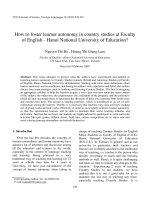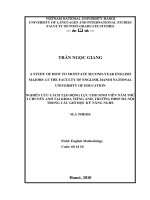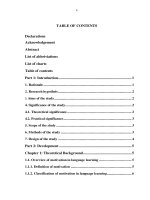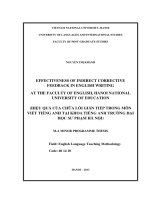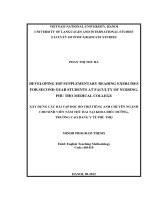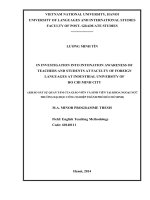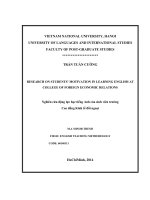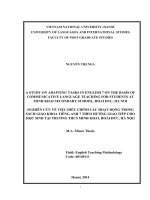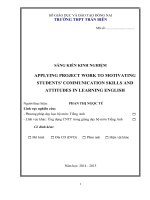USING QUIZLET IN LEARNING ENGLISH VOCABULARY FOR STUDENTS AT FACULTY OF ENGLISH, HANOI NATIONAL UNIVERSITY OF EDUCATION
Bạn đang xem bản rút gọn của tài liệu. Xem và tải ngay bản đầy đủ của tài liệu tại đây (1.3 MB, 38 trang )
HANOI NATIONAL UNIVERSITY OF EDUCATION
FACULTY OF ENGLISH
STUDENT RESEARCH PAPER
USING QUIZLET IN LEARNING ENGLISH
VOCABULARY FOR STUDENTS AT
FACULTY OF ENGLISH, HANOI NATIONAL
UNIVERSITY OF EDUCATION
STUDENT’S NAME
CLASS
: Ma Hong Anh
Truong Bich Huyen
: K64A
SUPERVISOR’S NAME
: Bui Thi Anh Van (M.A)
Hanoi (03/2016)
Contents
Acknowledgement
We wish to express sincere gratitude to Ms. Bui Thi Anh Van for her
incredible support throughout the research process. Without her detailed
guidance, we would not have been able to successfully complete this
research paper.
4
I.
Rationale
When it comes to learning a new language, the four critical skills to master
are reading, writing, listening and speaking. To reach a certain level of
proficiency, learners have to possess not only proper grammar, but more
importantly, sufficient lexical resources. Indeed, Beglar and Hunt (2005) claimed
that vocabulary learning is “the central component in successful foreign language
acquisition”. So, how can we define “sufficient” in this context? In order to
comprehend second language (L2) discourse, a language student must typically
learn thousands of words. How many thousands depends on the kind of
discourse. Research has shown that one must know at least 95% of the words in a
given written or spoken text in order to understand it ( (Hsueh-Chao & Nation,
2000). Therefore, it is becoming increasingly important to build up a large store
of words.
However, not everyone knows exactly the most suitable and efficient way to
learn new words. As a result, vocabulary-building strategies and resources are
gradually receiving greater attention from teachers and students alike. Thousands
of surveys and research have been carried out, followed by a number of creative,
helpful learning methods introduced to L2 learners. In this research, we would
like to focus on one single vocabulary enhancing tool that we find exciting and
adaptable to this new generation of students: Technology.
In the last years we have been able to observe an increase in using technology
in education which does not involve only computers but also tablets,
smartphones, Internet and all other modern tools of the 21st century. Several
surveys have been conducted to validate the fact that technology using in
teaching and learning is on the rise. According to a recent survey carried out by
Versal in 2014 and 2015, teachers’ use of online tools increased by 6% (from
47% to 53%), the majority of assignments given to students is Internet-based.
5
So, why is it that technology holds such a great impact on the modification of
teachers’ teaching methods? It has been proven that integrating technology into
education brings positive results in enhancing students’ motivation both
intrinsically and extrinsically. Creating activities that arouse students’ curiosity
and intrigue their interests in learning is without question a challenging task for
teachers of all subjects. Introducing technology infused lessons may prove to be a
beneficial motivator for every grade level. Because today’s students grow up
with a different digital landscape from their teachers’ (Jukes, 2008), they, most
likely, are inspired and motivated by different technology (Granito &
Chernobilsky, 2012). An average teenager would probably rather spend hours in
front of the computer’s screen than sit still for just 15 minutes reading textbooks.
Thus, it seems like a brilliant idea to incorporating education with digital media.
Today’s digital natives speak a different language than their teachers do
(Prensky, 2001). In a more digital world, online teaching tools are better for
students’ memory (Miller, 2009). Online tools that promote content creation
among students, such as videos, audio podcasts, and webpages, are more
effective strategies than traditional methods (Miller) (Granito & Chernobilsky,
2012). In conclusion, technology integrated teaching and learning methods boost
students’ motivation and enhance their academic results.
Among several ways that technology can be infused with education, we chose
to take a closer look into the use of digital media to learn vocabulary, more
specifically the use of Quizlet for its attractiveness and intuitiveness. Also, unlike
some of the other systems, Quizlet is completely free. Quizlet provides access to
millions of sets of flashcards created by users. Cards can be made from scratch or
copied and modified from existing sets. Quizlet, like many of the alternative
flashcard sites available, allows users to customize their flashcards and several
arrangements are possible, including the use of multiple languages and images.
The Quizlet site also includes a text-to speech audio function, giving users the
option of hearing as well as reading card content. In a recent study, Quizlet was
6
found to be more effective than using paper flashcards at improving vocabulary
test scores (Imrie, 2014).
The aim of this research is to examine the apparent superiority of Quizlet and
digital flashcards in general. In order to accomplish that, we actually made
various types of Quizlet activities and had a number of second year students who
major in English try learning a few sets of vocabulary through those activities.
After working on the data, we will give clear answers to the following research
questions:
-
To what extent do students evaluate their interest in learning vocabulary
using Quizlet and its effectiveness?
-
In what ways should students employ Quizlet to learn new words the most
effectively?
II.
Literature Review
II.1. Vocabulary learning and its importance in L2 learning.
Vocabulary is the knowledge of meanings of words. As mentioned in the
rationale, there are four main language skills to be acquired, classified into two
categories: productive skills and receptive skills. Similarly, knowledge of words
can also be categorized into two forms: productive and receptive (Kamil &
Hiebert, 2005).
Productive vocabulary is a set of words which can be used when writing or
speaking. Most of them are well-known, common and frequently used words. In
contrast, receptive or recognition vocabulary is that set of words, often less
frequent in use, for which an individual can assign meanings when reading or
listening. In general, receptive vocabulary is larger than productive vocabulary.
During the process of learning a second language, vocabulary refers to one of
four types, each of which represents a progressively increasing mastery of
vocabulary terms. These four types are listening vocabulary, speaking
vocabulary, reading vocabulary and writing vocabulary. The first two types relate
7
to oral use of language, whereas the latter two are typically developed during the
school years.
Vocabulary knowledge has been recognized as a critical tool for second
language learners for the past decades. Many studies have been conducted to
have an insight into why vocabulary plays such an important role when it comes
to language learning, even when it seems to be rather obvious. Underscoring the
importance of vocabulary acquisition, Schmitt (2000) emphasizes that “lexical
knowledge is central to communicative competence and to the acquisition of a
second language” p. 55).
Researchers such as Laufer and Nation (1999), Maximo (2000), Read (2000),
Gu (2003), Marion (2008) and Nation (2011) and others have realized that the
acquisition of vocabulary is essential for successful second language use and
plays an important role in the formation of complete spoken and written texts
(cited in Mofareh Alqahtani, 2015). Rivers and Nunan (1991), furthermore,
argue that the acquisition of an adequate vocabulary is essential for successful
second language use because without an extensive vocabulary, we will be unable
to use the structures and functions we may have learned for comprehensible
communication. Research has shown that second language readers rely heavily
on vocabulary knowledge and the lack of that knowledge is the main and the
largest obstacle for L2 readers to overcome (Huckin, 1995).
Being of paramount importance, vocabulary, on the other hand, has been
acknowledged as L2 learners’ greatest single source of problems (Meara, 1980).
Unlike syntax and phonology, vocabulary has no specific rules that language
learners can follow; therefore, they have no choice but to learn by heart all the
words they met throughout the learning process. In other words, it is not clear in
L2 vocabulary learning what rules apply or which vocabulary items should be
learned first. Another reason is that the vocabulary system is open-ended. Oxford
(1990) also claims that vocabulary is “by far the most sizeable and unmanageable
component in the learning of any language, whether a foreign or one’s mother
tongue, because of tens of thousands of different meanings”. Despite the extreme
8
difficulties coming from learning vocabulary, learners still have to deal with it on
a regular basis, for ‘‘vocabulary has traditionally been one of the language
components measured in language tests’’ (Schmitt, 1999).
Acknowledging the importance of vocabulary learning and several problems
faced by L2 learners, researchers have worked hard for the past decades to find
out the effective ways to make it easier for students to learn new words. This
research will look at a technology integrated learning method: using web-based
flashcards.
II.2. The importance of using technology in L2 learning.
As mentioned in the rationale, more and more people nowadays have access
to modern devices such as computers, tablets, smart phones. Accompanying the
diverse types of technology is the widespread use of the Internet, which has been
one of the most essential parts of most people. The most modern technologies of
the 21st century found their way into almost every part of each industry. Among
the industries that push technology forward the most belong the military or the
health care industry but the one we get in touch the most with is the
entertainment industry (Ondřej Rambousek, 2014).
Now since most students are in touch with modern technologies and they
know how to work with them, the time has come for technologies to be in the
education industry as well. They can provide many alternative ways of looking at
education (Saettler, 2004, p. 154) and help improve the old methods and evolve
the new methods of teaching. Technologies in education are not limited only to
the space of the classroom but have the ability to reach out beyond the walls of
the classroom and change many free time activities into educational activities.
In the 1960s teachers started to use tape recorders, language laboratories and
videos (Dudeney & Hockly, 2007, p.7). The next phase of using technologies in
education was Computer Assisted Language Learning also known as CALL
which appeared in the 1980s. Call is “the search for and study of applications of
the computer in language teaching and learning (Levy, 1997, p. 1). It contains
gap filling exercises, matching sentence halves or multiple-choice activities
(Beatty, New York, p. 8). These were the very first modern technology options
9
for teachers and they provided very simple activities which are still used today
like for example digital games directly or indirectly connected to learning
(Thomas, Reinders, & Warschauer, 2012, p. 10), cited in Megan Clark (2013).
On the other hand, technology in education can also be used outside the
classroom. Learners are more active and open to online Wikipedia, in which they
can find every source of information needed to complete their assignments or to
simply satisfy their curiosity of certain learning aspects without having to depend
on the teachers.
Technology and technological devices can be used to motivate and engage
English language learners’ in the development of literacy and language skills
(Traore & Kyei-Blankson, 2011; Ware, 2008). Learning a new language requires
incredible patience and nerves; therefore, if not being sufficiently motivated
during the long and tedious learning process, learners might be discouraged to try
harder. Research has shown that technology can help motivate students to be
more engaged in reading, especially when they interact with the text using certain
interactive technological tools. By utilizing various kinds of technological
devices, language learners gain a “sense of freedom, motivation, and
encouragement they need for learning” (Megan Clark, 2013).
Frank and Golonka concluded that “technology use has the potential to enhance
five primary functionalities of foreign language learning and teaching” (Frank et
al., 2008, p. 1). They are:
•
Organization: Technology enables learners and teachers to organize
learning and instruction outside of the classroom, and it enables learners to
reflect on and take control of their own learning.
•
Input: Technology expands access to a broader range of rich target
language input than is available in the classroom and/or provided by the
curriculum, and it creates opportunities to individualize input.
•
Output and interaction: Technology expands opportunities for learners to
create their own output and to interact synchronously or asynchronously with
native speakers and more proficient peers outside of the classroom.
•
Feedback: Technology creates opportunities to give and receive
individualized, maximally effective feedback.
10
•
Collaboration:
Technology
enables
collaborative,
social
learning
synchronously or asynchronously outside of the classroom.
Among several ways to integrate technology with language learning, we chose to
take a closer look into the use of digital flashcards to learn vocabulary, which has
been proven to be of great importance earlier in this research paper.
II.3. Quizlet and some activities using Quizlet
Nowadays, thanks to the development of technology, instead of learning
vocabulary with traditional paper flashcards, EFL learners could use digital
flashcards to enrich their vocabulary size. The benefits of web-based flashcard
programs may even outweigh those of paper-based ones. For instance, they can
also track students’ learning progress over time, promote motivation by
strategically introducing new words, present vocabulary using multimedia, and
allow learners to study at any time in any location with an internet connection
(Allum, 2003; Altiner, 2011, Hulstijn, 2001, McLean, Hogg, & Rush, 2013;
Nakata, 2011), cited in
TESL-EJ
(Web-based Vocabulary Learning with Quizlet,
2015)
There is a number of Web 2.0 vocabulary learning applications available,
such as Anki (ankisrs.net), Quizlet (quizlet.com), and Word Engine
(wordengine.jp). However, Quizlet was chosen as the focus of this study.
Quizlet is a free website providing learning tools for students, including
flashcards, study and game modes. It is one of the most widely used flashcard
websites and has more than one million registered users and eighty million
visitors, and is a repository for over thirty million user-generated study set
(Quizlet, 2014).
Currently, study sets in Quizlet are available for everyone without registering
for an account. Nevertheless, if you want to create your own study sets, you have
to sign up. Once registered, users can get access to several Quizlet’s study tools,
as mentioned below:
11
•
Flashcards Mode (shown in figure 1): Users start learning terms and their
definitions by “flip” or “flow” the cards. The audio function provides learners
with a useful model of pronunciation, and it can also be slowed down. This
learning mode promotes not only learners’ productive, but also their receptive
vocabulary knowledge (Nation, 2008).
Figure 1: Flashcard mode
•
Learn Mode: This mode (shown in figure 2) prompts the users with the
written or spoken form of one side of a card. A correct answer is put in the
“Correct” bucket, and an incorrect answer is put in the “Incorrect” bucket. If the
learners do not know the answer and select “Don’t Know”, Learn makes you
retype the answer correctly to continue. It keeps track of what learners know and
what they do not and retest them on their mistakes. At the end, Quizlet gives a
final score for learners to evaluate their progress.
12
Figure 2: Learn mode
•
Speller Mode: In the Speller option (shown in figure 3), learners need to
type what they hear. If they type it correctly, they can move on to the next
question. If there is a mistake in their answer, Speller indicates which letters
users have missed so they can retry. This mode is perfect for people who want to
revise the pronunciation and spelling of a term.
Figure 3: Speller mode
•
Test Mode: In Test Mode (shown in figure 4), Quizlet will automatically
generate a random test using the terms and definitions from users’ set of
flashcards. Learners are able to customize Question Types (Written, Matching,
Multiple Choice, and True/False), Prompt (Term, Definition, or both), and
13
Question Limit. When finishing the test, users click “Check Answers” at the
bottom of the page to see how they did. This mode is highly beneficial as it can
be conducted as an assessment tool in the classroom.
Figure 4: Test mode
•
Game Mode: Quizlet keeps learning lively with two game activities,
Scatter and Gravity. In Scatter (shown in figure 5), a number of terms and their
corresponding definitions are distributed randomly over the screen. What players
need to do is matching the terms and definitions by dragging them with the
mouse in the fastest time possible. In Gravity (shown in figure 6), learners have
to type in the correct answer to destroy asteroids before they hit. Because it
requires students to actually type in the answer, the game pushes them to really
learn the materials. These two games not only enable learners to practice recall
and typing skill but also arouse competitiveness among them, for it has the High
Score Table.
14
Figure 5: Scatter mode
Figure 6: Gravity mode
III.
Methods
III.1. Participants
The participants involved in this action research study consisted of 22 second
year students in class 64A, faculty of English, Hanoi National University of
Education. There were 22 girls participating in this study, and all of them major
in English. In this semester, their course aims at improving their English
15
language proficiency from B1+ to B2 level according to Common European
Framework of Reference.
These 22 sophomores are chosen to be the subject of this action research for
several reasons. Firstly, as their aim in the 4th semester is to develop their
English language proficiency at B2 level, their lexical resource is of paramount
importance, for it shows their language capacity. Research has shown that the
vocabulary size of B2 level learners should be from 3250 to 3750 words and
expressions (Milton, 2010). Therefore, it is absolutely crucial for 22 participants
to possess a good range of vocabulary if they want to achieve the goal. Secondly,
being class 64A’s members means that we will have great deal of time to observe
and evaluate our classmates’ performance.
III.2. Research instruments
This study is an action research that employs both qualitative and quantitative
methods. The first research instrument employed is a pre-test. This test consisted
of 45 questions in 6 exercises. These exercises varied in types, which were
jumbled words, crossword, matching the words with their definitions, word
search, filling in the blanks, and finding one correct word for each picture.
Student’s work was scored in order to see the final results. The purpose of this
pre-test was to measure the vocabulary size of 22 participants about 3 topics:
School, Talking about Food, Babies & children (see appendix I).
The second research instrument employed is self-study activities. The link of
3 Quizlet sets on was sent to all participants. Participants were
asked to study these 3 sets outside the class. Once they had finished all 3 Quizlet
sets designed by the researchers, they were recommended to create their own
study set (see appendix II). Afterwards, the link of their study sets should be sent
to the researchers. In such a way, the participants could fully experience every
function of Quizlet. Not only were they given a chance to broaden their lexical
resource provided by the researchers, but they would also have an insight of how
Quizlet really worked through the making of their study sets. In addition, the
16
links sent to the researchers ensured their participation in the self-study activities,
making the research findings more convincing and trustworthy.
The third research instrument employed is a survey questionnaire. Each
participant was given a 10-question survey to complete after finishing activities
on Quizlet. This survey allowed the researchers to examine how the participants
evaluate the Quizlet in both fields of interest and effectiveness (see appendix III)
III.3. Data collection procedure
There are three steps of data collection procedure, which are:
Pre-testing participants’ vocabulary size
Organizing self-study activities
Conducting a survey questionnaire
Firstly, participants’ vocabulary size was tested using a vocabulary worksheet
•
•
•
mentioned in the Research Instruments. Then, they were sent a link to Quizlet
website, in which we had designed 3 sets of lexical resource on 3 familiar topics.
After 1 week of self-studying, we conducted a survey (see appendix III) to
collect all the data needed to examine the effectiveness of using Quizlet to learn
vocabulary.
III.4. Data analysis
After data were collected, we analysed them quantitatively and qualitatively
to find out the results of pre-test, then analysed and synthesized the results of
survey questionnaire and write the results according to some main points: results
of pre-test, students’ attitude towards the effectiveness of using Quizlet in
learning vocabulary.
IV.
Findings
After analysing and synthesizing the pre-test and survey questionnaire
employed, the results will be now demonstrated in this part.
17
IV.1. Pre-test
Figure 7 Results of the Pre-test
Figure 7 shows the results of the pre-test. As can be seen from the chart, most
participants did not perform well on the test, receiving rather low scores ranging
from 0-29 pts in the total of 45, whereas only 14% of the participants surpassed
the average score. This may result from the fact that their vocabulary knowledge
in the topics given is limited.
For these participants all major in English, especially when they have already
reached B1+ level, it can be seen that their vocabulary level has not met the
requirement. Indeed, the pre-test only focused on 3 topics, yet they are all
familiar topics: School, Talking about food, Babies & children. This proves that
vocabulary studying at school is not sufficient, which resorts to different
vocabulary learning method outside the classroom, such as Quizlet.
18
IV.2. Students’ attitude towards the effectiveness of using Quizlet in
studying English vocabulary
Figure 8 Quizlet’s effectiveness evaluation
The ideas of participants about their own use of Quizlet are illustrated in
figure 8. It is noticeable that most participants agreed that Quizlet is an effective
tool to learn lexical resource, given the fact that 63.64% of participants highly
appreciate the experience with Quizlet.
19
Figure 9 Quizlet’s Effectiveness evaluation in 4 aspects
Figure 9 shows the results from the Likert scale given to the students. In
this research, the effectiveness was evaluated in 4 aspects, according to 4 modes
of Quizlet (Flashcard mode, Speller mode, Learn mode and Game mode). It can
be seen that the Learn mode was considered the most effective learning tool,
scoring 4.55 out of 5 in the extent of effectiveness. The other 3 mode which were
Flashcard, Speller, and Game had the weighted average of 3.64, 4.09, 4.09
respectively. This proved that all 4 Quizlet study modes were of great help.
20
Figure 10 Quizlet’s ease of use
Figure 10 shows how participants evaluate the Quizlet ease of use. The
result indicates that the majority of students agreed that Quizlet is not too
difficult to use (only 1 people rated Quizlet 2 points in terms of ease of use).
IV.3 Students’ attitude towards the motivation enhancement of using
Quizlet
21
Figure 11 Students’ interest in using Quizlet
Figure 11 gives information about the interest of students when studying on
Quizlet. None of them finds Quizlet unexciting.
Figure 12 Students’ favourite study modes in Quizlet
Figure 12 illustrates the most favourite mode on Quizlet. It is clear that
Speller Mode takes the lead as it accounts for 45.45% of students’ choices. The
second highest mode is Game Mode (27.27%), while the figures for Flashcard
Mode and Test Mode are 22.73% and 4.55% respectively. The Learn Mode is the
least favourite mode on Quizlet.
22
Figure 13 Students’ willingness to continue using Quizlet
Figure 13 shows how willing the participants are to start using Quizlet to
learn vocabulary regularly. Quizlet is considered to be the number 1 tool when
learning new words by 7 participants (31.82%). The rest said that they would
give it a try once in a while
In brief, the utility of Quizlet in language learning receives positive feedback
from second year students at K64A, FOE, HNUE.
IV.4. Study Implication
The findings of the current study have practical implications for supporting
intentional vocabulary learning with the use of Quizlet. In the classroom, lessons
can be designed in Flashcard Mode, which makes it easier for the teacher to
introduce the new concepts in L2. Students should also be educated about the
effective use of Quizlet (e.g. the amount and timing of practice), and this can be
implemented through explicit strategy instruction at the beginning of a language
course. For self-studying, teachers may advise students to use flashcards for selftesting or repeated retrieval of words. Students should be required to use Quizlet
23
to learn vocabulary deliberately and actively outside the classroom. More
importantly, the collaborative learning potential of Quizlet also needs to be
mentioned. Previously, learning vocabulary with flashcards is considered more of
an individual task. However, learning through Quizlet can be repurposed for
collaborative learning tasks to allow for better peer support. Some activities can
be organized to have students work collaboratively and expose them to the
interactive use of vocabulary, such as co-constructing vocabulary flashcards,
testing each other on new words, and negotiating word meanings in
communication. Ideally, the proposed technique of learning vocabulary
deliberately with Quizlet can and should be used to provide collaborative
learning opportunities for lexical development in and out of class.
24
V.
Conclusions
Earlier in this paper, we have posed two research questions:
To what extent do students evaluate their interest in learning vocabulary
using Quizlet and its effectiveness?
In what ways should students employ Quizlet to learn new words the most
effectively?
This paper has successfully found out the answers to the two research
questions above. Students at the beginning of the study took the pre-test with not
very high scores, after trying some activities with Quizlet felt that these
interesting activities enable them to study English vocabulary more easily and
more effectively. Furthermore, in the self-study activities, the participants
confirmed that the most efficient way to learn new words using Quizlet was to
design their own study sets, then exchange them with classmates. Thus, students
would be able to learn from one another, to give feedback and comments to their
friends.
However, there are some limitations of this study, namely: the lack of a
sufficient number or participants, the limited number of tasks designed for selfstudy which may result in biased findings. It is also the suggestion for later study.
Those who are interested in this study can conduct their survey in a larger
number of students of a faculty of English or even non-majored English students
at a university, with a larger number of vocabularies to study and activities to try.
By doing this, the study would bring about fruitful results later on.
References
Ashcroft, R. J., & Imrie, A. C. (2014). Learning Vocabulary with Digital
Flashcards. JALT, (pp. 639-646). Tokyo.
Clark, M. (2013). The Use of Technology to Support Vocabulary. Fisher Digital
Publications.
Dang, T. H. (August, 2015). The Electronic Journal for English as a Second
Language. Retrieved from />Dreyer, J. (2014). The Effect of Computer-based Self-access Learning on
Weekly Vocabulary Test Scores. Studies In Self-access Learning Journal,
217-234.
Granito, M., & Chernobilsky, E. (2012). The Effect of Technology on a Student's
Motivation and Knowledge Retention. NERA Confrence Proceedings
2012, (p. 17).
Hidayah, T. (2010). Vocabulary and its importance in ELT.
Hsueh-Chao, M. H., & Nation, P. (2000). Unknown Vocabulary Density and
Reading Comprehension. Reading In A Foreign Language, 403-430.
Hunt, A., & Beglar, D. (2015). A framework for developing EFL reading
vocabulary. Reading In A Foreign Language, Volume 17, Number 1.
Kamil, M., & Hiebert, E. H. (2005). The Teaching and Learning of Vocabulary:
Perspectives and Persistent Issues. New Jersey: Lawrence Erlbaum
Associates.
Meara, P. (1995). The Language Teacher.
Milton, J. (2010). The development of vocabulary breadth across the CEFR
levels. Eurosla.
Mofarel, A. (Vol. III, No. 3 / 2015). The Importance Of Vocabulary In Language
Learning And How To Be Taught. International Journal of Teaching and
Education, 21-34.
Rambousek, O. (2014). Learning vocabulary with technology.
